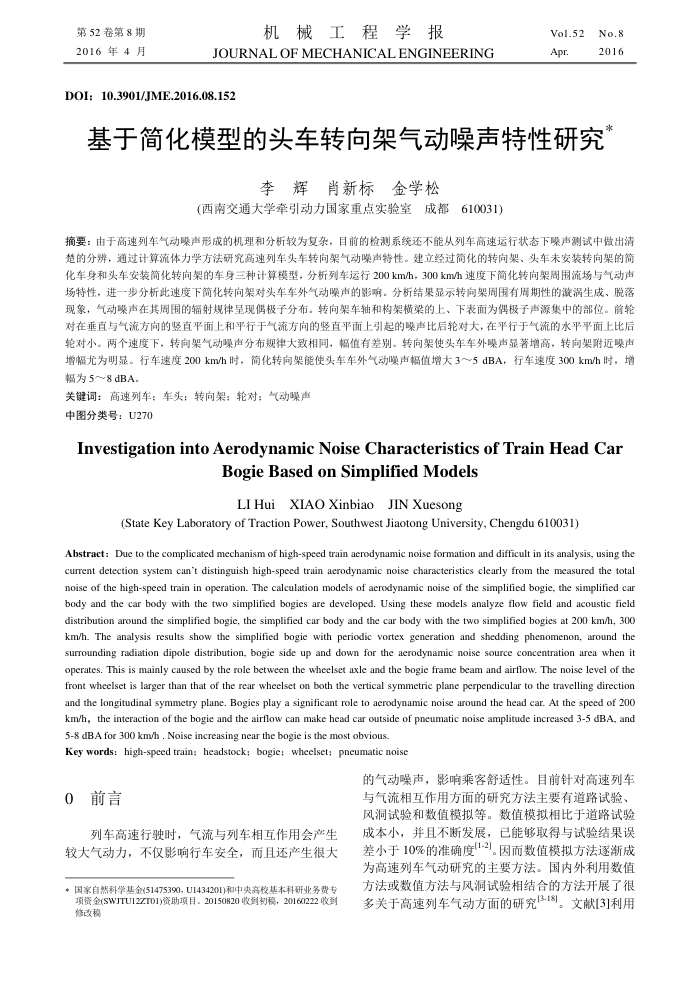您当前的位置:首页>论文资料>基于简化模型的头车转向架气动噪声特性研究
内容简介
 第52卷第8期 2016年4月
第52卷第8期 2016年4月机械工程学报
JOURNALOF MECHANICALENGINEERING
DOI:10.3901/JME.2016.08.152
Vol.52 Apr.
No.8 2016
基于简化模型的头车转向架气动噪声特性研究
李辉肖新标金学松
(西南交通大学牵引动力国家重点实验室成都
610031)
摘要:由于高速列车气动噪声形成的机理和分析较为复杂,目前的检测系统还不能从列车高速运行状态下噪声测试中做出清楚的分辨,通过计算流体力学方法研究高速列车头车转向架气动噪声特性。建立经过简化的转向架、头车未安装转向架的简化车身和头车安装简化转向架的车身三种计算模型,分析列车运行200km/h,300km/h速度下简化转向架周围流场与气动声场特性,进一步分析此速度下简化转向架对头车车外气动噪声的影响。分析结果显示转向架周围有周期性的凝涡生成、脱落现象,气动噪声在其周围的辐射规律呈现偶极子分布。转向架车轴和构架横架的上、下表面为偶极子声源集中的部位。前轮对在垂直与气流方向的竖直平面而上和平行于气流方向的竖直平面上引起的噪声比后轮对大,在平行于气流的水平平面上比后轮对小。两个速度下,转向架气动噪声分布规律大致相同,幅值有差别。转向架使头车车外噪声显著增高,转向架附近噪声增幅尤为明显。行车速度200km/h时,简化转向架能使头车车外气动噪声幅值增大3~5dBA,行车速度300km/h时,增幅为5~8dBA.
关键词:高速列车:车头:转向架:轮对:气动噪声中图分类号:U270
InvestigationintoAerodynamicNoiseCharacteristics of TrainHeadCar
BogieBased on Simplified Models LIHuiXIAO XinbiaoJINXuesong
(State Key Laboratory of Traction Power,Southwest Jiaotong University,Chengdu 610031)
snsee s na pe geo aso aeae en paase o seaa paeaido o ane eseeeeeasa noise of the high-speed train in operation. The calculation models of aerodynamic noise of the simplified bogie, the simplified car body and the car body with the two simplified bogies are developed. Using these models analyze flow field and acoustic field
distribution around the simplified bogie, the simplifiec
km/h. The analysis results show
the
surrounding radiation dipole distributio
litiec
operates, This is mainly caused by the r
rolebe
front wheelset is larger than that
ofth
with
and the longitudinal symmetry plane,Bogies play a signific
km/h, the interaction of the bo
andthe
airflow
andthe poua
body with the two simplified bogies at 200 km/h, 300
and shedding phenomenon, around the
generation
mio
centration area when it
ogie frame beam and airflow. The noise level of thc
plane perpendicular to the travelling direction
ierodynamic noise around the head car. At the speed of 200 outside of pneumatic noise amplitude increased 3-5 dBA, and
5-8 dBA for 30o km/h . Noise increasing near the bogie is the most obvious. Key words: high-speed train: headstock;
pneumatic noise
bogie:
wheelset;
的气动噪声,影响乘客舒适性。目前针对高速列车
0
前言
列车高速行驶时,气流与列车相互作用会产生
较大气动力,不仅影响行车安全,而且还产生很大 +国家自然科学基金(51475390,U1434201)和中央高校基本科研业务费专项资金(SWJTU12ZT01)资助项目-20150820收到初稿,20160222收到修改稿
与气流相互作用方面的研究方法主要有道路试验、风洞试验和数值模拟等。数值模拟相比于道路试验成本小,并且不断发展,已能够取得与试验结果误差小于10%的准确度[1-2]。因而数值模拟方法逐渐成为高速列车气动研究的主要方法。国内外利用数值方法或数值方法与风洞试验相结合的方法开展了很多关于高速列车气动方面的研究[3-18]。文献[3]利用
上一章:拖车转向架气动噪声数值研究
下一章:基于PLC和触摸屏的气动机械手控制系统设计